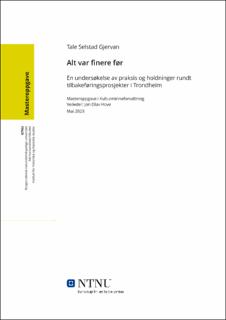| dc.contributor.advisor | Hove, Jon Olav | |
| dc.contributor.author | Gjervan, Tale Selstad | |
| dc.date.accessioned | 2023-07-04T17:25:05Z | |
| dc.date.available | 2023-07-04T17:25:05Z | |
| dc.date.issued | 2023 | |
| dc.identifier | no.ntnu:inspera:144933143:22777670 | |
| dc.identifier.uri | https://hdl.handle.net/11250/3075930 | |
| dc.description.abstract | Denne masteroppgaven, som har sitt utspring i praksisperioden gjennomført høsten 2022 hos byantikvaren i Trondheim, handler om tilbakeføring av bygninger i Trondheim. Problemstillingen er «hvilke syn på kulturarv reflekteres gjennom tilbakeføringsprosjektene i Trondheim?». For å kunne svare på dette undersøker jeg flere ting. Disse er hvilke begrep om autentisitet og tilbakeføring som er relevante å bruke innen dagens kulturminnevern. Hvorfor og hvordan de tilbakefører, og hvilke syn de ha på bygninger. Jeg undersøker også hvilke syn på og holdninger til autentisitet som er fremtredende hos de ulike aktørene, og til slutt hvordan interaksjonen mellom de innenfor og utenfor forvaltningen er. Dette er undersøkt gjennom å intervjue aktører både innenfor og utenfor forvaltningen som har gjennomført tilbakeføringsprosjekter i Trondheim, og dermed se deres svar og syn opp mot relevant teori om tema. Disse prosjektene er Sukkerhuset, Lademoen stasjon, Jomfrugata 5 og Thingvallagården.
I oppgaven kommer jeg frem til at Hans-Henrik Egede-Nissens begreper for rekonstruksjon og restaurering, som begge er to måter å gjennomføre tilbakeføring på, er mest aktuelle å bruke i dagens bygningsvern, men at det likevel er en overlapp mellom disse begrepene. Dermed er det mest hensiktsmessig å bruke det overordnede begrepet tilbakeføring. Angående autentisitet er det Nara-dokumentets begrep som er relevant å bruke i dag. Alle prosjektene begynte med behov for istandsetting, men flere velger å tilbakeføre av estetiske årsaker. Alle prosjektene bruker fasadisme og aemulatio som fremgangsmåter, og ser på byggene som monumenter, men har skapt palimpsester eller breccia. Alle aktørene setter autentisitet høyt, og bruker mange strategier for å oppnå disse. Blant annet dokumentasjon, tradisjonshåndverk og å skjule elementer påkrevd ut fra moderne krav. Autentisitet i form og design er viktigst for de utenfor forvaltingen, og patina er også viktig for disse. De innenfor forvaltningen legger mer verdi i autentisitet i materialer og substans. Når det kommer til interaksjonen mellom disse aktørene, kan de innen forvaltingen funger som en brems i prosjektene og sikre for eksempel materiell autentisitet. Men det at flere ulike aktører gjennomfører tilbakeføringer fører til demokratisering av kulturarven. | |
| dc.description.abstract | This master´s thesis, which has its origins in my internship at Byantikvaren in Trondheim in the fall of 2022, is about, what we in Norwegian call “tilbakeføring”. There is no good translation of this term into English, but it is about returning a building back to a known earlier state. I investigate how different actors approach this in Trondheim. The research question for this thesis is therefore “what views on cultural heritage is reflected through the act of returning buildings back their former known states in Trondheim?”. To answer thos question I investigate several things. These things are which understandings and terms for authenticity and returning building back their former states are relevant to use in the field today. Why and how they return buildings back to their former states, and how they view buildings. I also look into what views and attitudes towards authenticity are prevalent among the different actors. And also, how the actor inside and outside the public administration of cultural heritage interact. To be able to answer this question I have conducted interviews with actors both inside and outside the public administration of cultural heritage in Trondheim. And I compare their answers and view with relevant theories on the topic. The projects I have chosen for the thesis are Sukkerhuset, Lademoen stasjon, Jomfrugata 5 and Thingvallagården.
I conclude with several things, that together make up an answer to my thesis´ research question. Firstly, that it is not fruitful to make a hard separation between restoration and reconstruction as two ways of returning buildings back to known earlier states. It is better to use the term “tilbakeføring”. It is the Nara-documents understandings and terminology for authenticity that are relevant to use in the field today. All the projects begin with a need for repairs, but several actors return buildings to for aesthetic reasons. They all use facadism and aemulatio in their work, and they all view their building as monuments, but have ended up making palimpsest or breccias. All the actors highly value authenticity, but in different ways, and use many different strategies to achieve authenticity. Those outside the public administration mostly value authenticity in form and design, and also patina is important. Those within the public administration mostly value authenticity in materials and substance. This is also important to those outside the public administration, but not a requisite, as it seems to be for those within the public administration. This characterizes the interaction between the two types of actors, in the way that those inside the administration help secure authenticity in materials so that not only visual authenticity is prioritized. In this way Authorized Heritage Discourse is a resource. Also, the fact that actors outside the admin do these kinds of project contribute to democratize the cultural heritage. | |
| dc.language | nob | |
| dc.publisher | NTNU | |
| dc.title | Alt var finere før.
En undersøkelse av praksis og holdninger rundt tilbakeføringsprosjekter i Trondheim. | |
| dc.type | Master thesis | |
